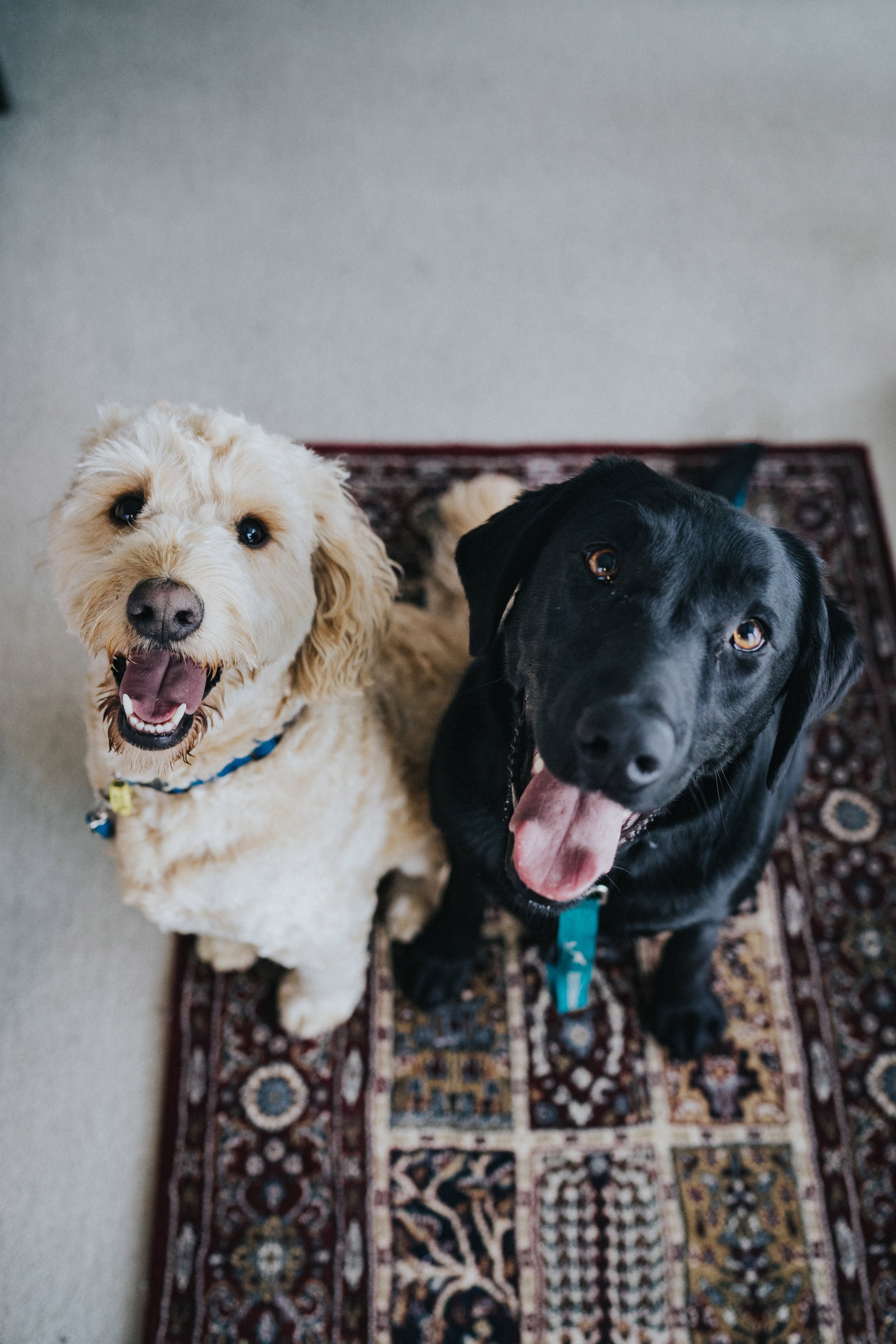by Claire Anderson
Since I was 22, and have almost always lived in a multiple pet household. It was usually dogs and cats, but there were an assortment of reptiles, small and furries, and amphibians as well. The most educational were my years spent fostering rescue dogs with Underdog Rescue in Minneapolis, Minnesota. In addition my own pup, Miles Davis, I usually had two additional furry tenants under my care. Sometimes they would stay for months, sometimes only days or weeks; but it was a revolving door of different dogs and cats coming in and out so I had to create a working system to ensure everyone (including me!) was safe and experiencing minimal stress. I also worked in a dog daycare that grew exponentially in the three years I was there, growing from an average of 30-40 dogs per day to 200+. This also required some quick and creative problem solving to safely and effectively manage a large pack of pups. My experience working with many dogs sharing a single space isn’t really something I have considered as a practical skill, but in truth I use this skill every single day, both professionally and personally.
Currently, I live in a home in Seattle, Washington with a sweet/mischievous 7 year old pit bull mix (Ziggy Starpup), an adorable 4 year old bearded dragon (P. Diddy), a ball python (Arlo Guthrie), and of course my soulmate, a 13 year old dachshund (Miles Davis). My skills and experience managing a multiple-pet household have been heavily utilized over the years—and put to the test!
To make your life easier, I have compiled a list of dos and don’ts to save unnecessary stress for you and your pets and to keep everyone safe. Living with multiple animals can be an amazing and fun experience and we are here to help!
1. Boundaries
Setting our pets up for success is extremely important and creating physical boundaries is often necessary in order to achieve this. There are many tools to assist in this, including ex-pens, baby gates, tethers (leashes), and doors. Here are a few examples of how these tools can be implemented:
While enjoying a daily dental chew, dogs Freddie and Maxine are closed into their crates to avoid any tension caused by resource guarding.
When Charlie the new rescue cat is added to the family, he stays in a separate room for a few days to allow everyone to adjust to the new smells.
While the family enjoys dinner around the table, the dogs are kept behind a baby gate to avoid any scuffles over a dropped food item.
You can also employ boundary training so you don’t even need physical boundaries! We can help you teach your pup to stay behind a boundary line of your choosing.
2. Exercise and Mental Enrichment
Photo by Patrick Pegg.
As always, exercise and mental enrichment are paramount to an animal’s health, well-being, and behavior. Walks are wonderful, but hikes in new places are better so they can explore all the news sights, sounds, and smells of a new environment! Pack walks can also be a fantastic way for animals to bond, especially dogs. In my current household, I walk with Ziggy daily, while Miles rides in a backpack. Sometimes I even let the bearded dragon ride on my shoulder! If you can safely run with multiple dogs, it can be even better exercise as it is important to raise the heart rate for fulfilling exercise.
“When high value items are involved like toys or food, be very careful and provide boundaries when necessary.”
For mental enrichment, there are many games you can play with multiple animals. Check out our article on fun and easy ways to provide mental enrichment to your pets. These things include nosework, puzzle toys, agility games, fetch, and many more!
3. Maintaining Individual Relationships
Photo by Miranda Wipperfurth on Unsplash
When living in a household with multiple pets, it can be easy for every activity to involve all the pets, especially when they are all dogs. For many reasons, it is necessary to give each pet individual quality time with you as their caretaker. First, it can prevent resource guarding issues by ensuring that each animal has enough attention. Secondly, it can prevent your animals from bonding so much so that they become codependent. On a personal, somewhat selfish level, it gives me time to really know my animal’s individual personalities and quirks.
Independence and autonomy and essential to an animal’s mental well-being. You can ensure this by giving each animal special training and play time in which they can make their own choices. The way I do this for my own dogs is utilizing nosework by playing “Find It” with each dog separately. Ziggy gets his time for the game on his walks and Miles plays it with me inside while Ziggy spends some time alone.
4. Health
In order for our pets to be on their best behavior, they have to feel good! If you are struggling to get your pets to get along, I recommend bringing them to the vet to make sure they are in good physical health. For example, say Buddy has a sore leg and Molly bumps into him. He may react aggressively because it hurts!
Great health begins with a healthy diet. Every species of animal (including humans) needs a complete and healthy diet to thrive. Of course, this means something different for each animal, so always consult with your vet to ensure you are feeding the best diet possible. We have a wonderful article about dog food specifically that may help if you are wondering about dog nutrition.
Here at Tully's Training, we pride ourselves on being a holistic dog training company that takes a "whole picture" approach to training, and we believe nutrition and exercise contribute to good behavior.
5. Training
Photo by Sneaky Elbow on Unsplash
There are three training techniques that I always use in a multiple dog household. Train each of these behaviors separately before using them together.
Teach each dog his or her place. You can use dogs beds, mats, or even a corner of the couch!
Train your pups to always sit and stay before going through doorways to avoid congestion in tight spaces.
Train your dogs to walk nicely on leash together.
For each of these behaviors, contact a positive reinforcement based trainer in your area to assist!
6. Safety First
Photo by Jay Wennington on Unsplash
The last thing we want to happen is for any injuries to happen to any of our animals. Within a multiple pet household, there are many opportunities for tension to arise. It is up to you are the caretaker or parent of your household to maintain a healthy, positive balance and keep stress to a minimum. First and foremost, this means ensuring a safe environment so that everyone can thrive. For example, if you have cats and dogs, provide many high perches that are accessible only to the cats so they can hide safely if they need. As discussed above, implement baby gates, crates, and tethers for dogs when necessary.
Occasionally, a muzzle may be necessary to ensure the safety of everyone. Muzzles can be a wonderful tool if you have a dog that has bitten in the past. Karen Pryor has a informative article about the reasons muzzle training is a great idea!
Lastly, until you are absolutely sure your pets are well socialized to one another, never leave them unsupervised together.
Living with a Variety of Species
We’ve all seen those adorable viral videos of interspecific interactions—the one that immediately comes to mind is the dachshund and the lion.
While these videos are heartwarming and ridiculously cute, the fact is that our responses to these videos can be dangerously anthropomorphic. It can cause people to put their pets in stressful and sometimes dangerous situations in their attempt to create similar relationships. Never allow multiple species to interact unless you are absolutely sure it is safe. It is not fair to them. For example, I would never put my lizard on Ziggy (even though the photograph would be adorable.)
Photo by Amber Kissner
Diddy, my bearded dragon, will hang out with the dogs on my bed. Even though I have seen absolutely zero aggression from Miles towards him, I am still extremely careful and supervise their interactions closely. When Ziggy originally met Diddy, he was a bit too interested in him, if you know what I mean. Ziggy has a pretty intense prey drive and it took months of training to get him to the point where he stopped fixating on him. When Diddy is out of his enclosure around Ziggy, I hold him and watch Ziggy closely. Realistically, I know that if something startled him and he moved quickly, it still may cause Ziggy to chase him.
Sharing your home with multiple pets can be a fun and rewarding experience, though stressful at times. As always, we are here to help! Schedule your free training consultation today!







